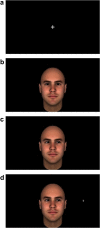Effect of race on Gaze Cueing in adults with high and low autistic traits
- PMID: 37715241
- PMCID: PMC10503147
- DOI: 10.1186/s40359-023-01307-y
Effect of race on Gaze Cueing in adults with high and low autistic traits
Abstract
Background: Observing the direction of gaze of another person leads to shifting of attention in the same direction (gaze-cueing effect - GCE), a social-cognitive ability known as joint or social attention. Racial attitudes can influence the magnitude of GCE since it has been shown that White people showing a strong race ingroup preference follow the gaze only of White, and not Black, faces. Individuals with high autistic traits have difficulties in social-cognitive abilities that can disrupt the learning of socially shared racial attitudes. Our aim was to investigate in White Italian adults whether individuals with higher autistic traits (measured by the Autism Spectrum Quotient) show reduced implicit racial bias (measured by the Implicit Association Test) and if this bias would lead to differences in the gaze cueing effect (GCE) triggered by gaze direction of faces of different races (measured by the Gaze Cueing Task).
Methods: In an online study, participants (N = 165; 132 females; Mean age = 22.9; SD = 4.76) filled in the Autism Spectrum Quotient (AQ) questionnaire, then performed a Gaze Cueing Task, followed and by an Implicit Association Test.
Results: Linear regression and linear mixed model analyses showed in the IAT task the presence of the same implicit ingroup bias for all participants, which was not predicted by the AQ score, while in the Gaze Cueing Task the GCE differed depending on the AQ score of the participants. Specifically, participants with low-medium, medium, and medium-high autistic traits (AQ = -1SD; AQ = mean; AQ = + 1SD respectively) presented the GCE for both ingroup and outgroup cueing faces, whereas participants with high autistic traits (AQ = + 2SD) only for ingroup faces.
Conclusions: In White Italian adults the presence of an implicit ingroup bias seems to influence the GCE, but it is not always true that the individuals showing an implicit ingroup bias do not orient their attention in the direction of gaze of the outgroup individuals. Instead, the GCE seems to be modulated by the level of autistic traits. That is, individuals with higher autistic traits seem to prioritize joint attention with only their ingroup members.
Keywords: Gaze-cueing effect; High and Low autistic traits; Implicit race bias; Ingroup bias.
© 2023. BioMed Central Ltd., part of Springer Nature.
Conflict of interest statement
All the authors declare no conflicts of interest.
Figures





Similar articles
-
A British understanding of racialised gaze-cueing in the context of implicit racial bias, explicit racial identity and self-esteem.Q J Exp Psychol (Hove). 2025 Apr 9:17470218251335304. doi: 10.1177/17470218251335304. Online ahead of print. Q J Exp Psychol (Hove). 2025. PMID: 40205730
-
Implicit social learning in relation to autistic-like traits.J Autism Dev Disord. 2012 Dec;42(12):2534-45. doi: 10.1007/s10803-012-1510-3. J Autism Dev Disord. 2012. PMID: 22447071
-
Gaze and arrow cueing of attention reveals individual differences along the autism spectrum as a function of target context.Br J Psychol. 2005 Feb;96(Pt 1):95-114. doi: 10.1348/000712604X15626. Br J Psychol. 2005. PMID: 15826326
-
Measuring autistic traits in the general population: a systematic review of the Autism-Spectrum Quotient (AQ) in a nonclinical population sample of 6,900 typical adult males and females.Mol Autism. 2015 Jan 14;6:2. doi: 10.1186/2040-2392-6-2. eCollection 2015. Mol Autism. 2015. PMID: 25874074 Free PMC article. Review.
-
Category learning in autistic individuals: A meta-analysis.Psychon Bull Rev. 2024 Apr;31(2):460-483. doi: 10.3758/s13423-023-02365-4. Epub 2023 Sep 6. Psychon Bull Rev. 2024. PMID: 37673843 Free PMC article. Review.
References
-
- Ciardo F, De Angelis J, Marino BFM, Actis-Grosso R, Ricciardelli P. Social categorization and joint attention: Interacting effects of age, sex, and social status. Acta Psychol (Amst). 2021;212. 10.1016/j.actpsy.2020.103223 - PubMed
-
- Driver J, Davis G, Ricciardelli P, Kidd P, Maxwell E, Baron-Cohen S. Gaze perception triggers reflexive visuospatial orienting. Vis Cogn. 1999;6(5):509–540. doi: 10.1080/135062899394920. - DOI
-
- Friesen CK, Kingstone A. The eyes have it! Reflexive orienting is triggered by nonpredictive gaze. Psychon Bull Rev. 1998;5(3):490–495. doi: 10.3758/BF03208827. - DOI
-
- Bruner JS. Child's talk: Learning to use language. Oxford: Oxford University Press; 1983.
MeSH terms
Grants and funding
LinkOut - more resources
Full Text Sources

